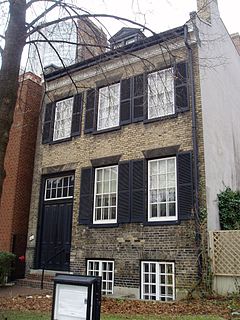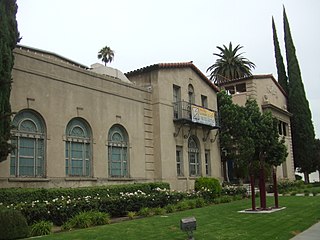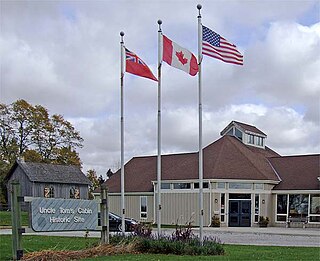Riverside describes anything on the bank of or alongside a river. It may refer to:

Riverside is a city in, and the county seat of, Riverside County, California, United States, located in the Inland Empire metropolitan area. It is named for its location beside the Santa Ana River. It is the most populous city in the Inland Empire and in Riverside County, and is located about 55 miles (89 km) east of downtown Los Angeles. It is also part of the Greater Los Angeles area. Riverside is the 59th most populous city in the United States and 12th most populous city in California. As of the 2010 Census, Riverside had a population of 303,871.

Riverside is a suburban village in Cook County, Illinois, United States. A significant portion of the village is in the Riverside Landscape Architecture District, designated a National Historic Landmark in 1970. The population of the village was 8,875 at the 2010 census. It is a suburb of Chicago, located roughly 9 miles (14 km) west of downtown Chicago and 2 miles (3 km) outside city limits.

Victorian architecture is a series of architectural revival styles in the mid-to-late 19th century. Victorian refers to the reign of Queen Victoria (1837–1901), called the Victorian era, during which period the styles known as Victorian were used in construction. However, many elements of what is typically termed "Victorian" architecture did not become popular until later in Victoria's reign. The styles often included interpretations and eclectic revivals of historic styles. The name represents the British and French custom of naming architectural styles for a reigning monarch. Within this naming and classification scheme, it followed Georgian architecture and later Regency architecture, and was succeeded by Edwardian architecture.

Osgoode Hall is a landmark building in downtown Toronto, Ontario, Canada. The original 2 1⁄2-storey building was started in 1829 and finished in 1832 from a design by John Ewart and William Warren Baldwin. The structure was named after William Osgoode, the first Chief Justice of Upper Canada.

The Mission Inn, now known as The Mission Inn Hotel & Spa, is a historic landmark hotel in downtown Riverside, California. Although a composite of many architectural styles, it is generally considered the largest Mission Revival Style building in the United States. Mission Inn Hotel & Spa is a member of Historic Hotels of America, the official program of the National Trust for Historic Preservation.

Mackenzie House is a historic building and museum in Toronto, Ontario, Canada that was the last home of William Lyon Mackenzie, the city's first mayor. It is now a museum operated by the City of Toronto's Museum and Heritage Services.

W. T. Preston is a specialized sternwheeler that operated as a snagboat, removing log jams and natural debris that prevented river navigation on several Puget Sound-area rivers. She is now the centerpiece of the Snagboat Heritage Center in Anacortes, Washington. She was designated a National Historic Landmark in 1989. Built in 1929, she is one of two surviving snagboats built and operated by the United States Army Corps of Engineers, and the only one on the American west coast.

Jack London State Historic Park, also known as Jack London Home and Ranch, is a California State Historic Park near Glen Ellen, California, United States, situated on the eastern slope of Sonoma Mountain. It includes the ruins of a house burned a few months before Jack London and family were to move in, a cottage in which they had lived, another house built later, and the graves of Jack London and his wife. The property is both a California Historical Landmark and a National Historic Landmark.

Kelham Island is one of Sheffield's eleven designated Quarters. Formerly an industrial area, the island itself was created by the building of a goit, or mill race, fed from the River Don to serve the water wheels powering the workshops of the areas' industrial heyday. The quarter was named after the island, however, the boundaries extend beyond the physical island created by the river and goit.

The Barnum House was built between 1817 and 1819 by Eliakim Barnum, a United Empire Loyalist originally from Vermont. The house, which stands just outside Grafton, Ontario, in Alnwick/Haldimand Township, is the earliest example of Neoclassical architecture in Canada. Barnum House was the first house museum to open in Ontario, restored and operated by the Architectural Conservancy of Ontario in 1940. It is currently owned and operated by the Ontario Heritage Trust.

Museum Windsor is a historical museum located in Windsor, Ontario, Canada which displays the city's rich and colourful past. It is located in the historic François Baby House, built in 1812 by François Baby, a prominent French-Canadian.

Riverside Art Museum is an art museum in the historic Mission Inn District of Riverside, California. A non-profit organization.

The Harada House is a historic house located on 3356 Lemon Street in Riverside, California. The house, created in 1884 and built upon by the Harada family, was the focus of a critical application of the California Alien Land Law of 1913, which prevented foreigners who were ineligible for citizenship from owning property. The state of California attempted to seize the property from the family in California v. Harada, but the Haradas ultimately won the case and retained ownership of the house. The house was declared a National Historic Landmark in 1990 and is currently overseen by the Riverside Metropolitan Museum.

San Timoteo Canyon is a river valley canyon southeast of Redlands, in the far northwestern foothills of the San Jacinto Mountains in the Inland Empire region of Southern California.
Hoover House may refer to:

Uncle Tom's Cabin Historic Site is an open-air museum and African American history centre near Dresden, Ontario, Canada, that includes the home of Josiah Henson, a former slave, author, abolitionist, and minister, who, through his 1849 autobiography The Life of Josiah Henson, Formerly a Slave, Now an Inhabitant of Canada, as Narrated by Himself, was the inspiration for Harriet Beecher Stowe's title character in her novel Uncle Tom's Cabin. The 5-acre (20,000 m2) complex is part of the original 200 acres (0.81 km2) of land purchased in 1841 to establish the Dawn Settlement, a community for escaped slaves.

The Jensen Alvarado Ranch is a historic park and museum in Riverside County, California, USA, and is operated by the Riverside County Regional Park and Open-Space District. It can be accessed from 4350 Riverview Drive, Rubidoux or 4307 Briggs Street, Riverside. It was the first kiln-fired brick building built in Riverside County, and is the oldest non-adobe structure in the Inland Empire.

Cornelius Boy Jensen was a Danish sea captain and Californian politician. Of the nine one-year terms that he served as county supervisor between 1856 and 1877, Jensen was the Chairman of the San Bernardino County Board of Supervisors four times. His Agua Mansa home, the Jensen Alvarado Ranch, is a registered California Historical Landmark and is listed on the National Register of Historic Places.















